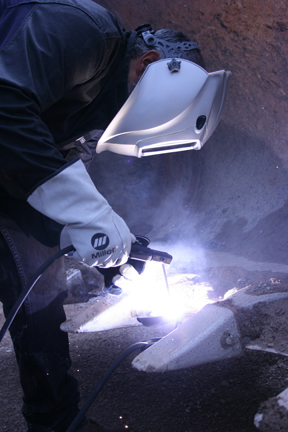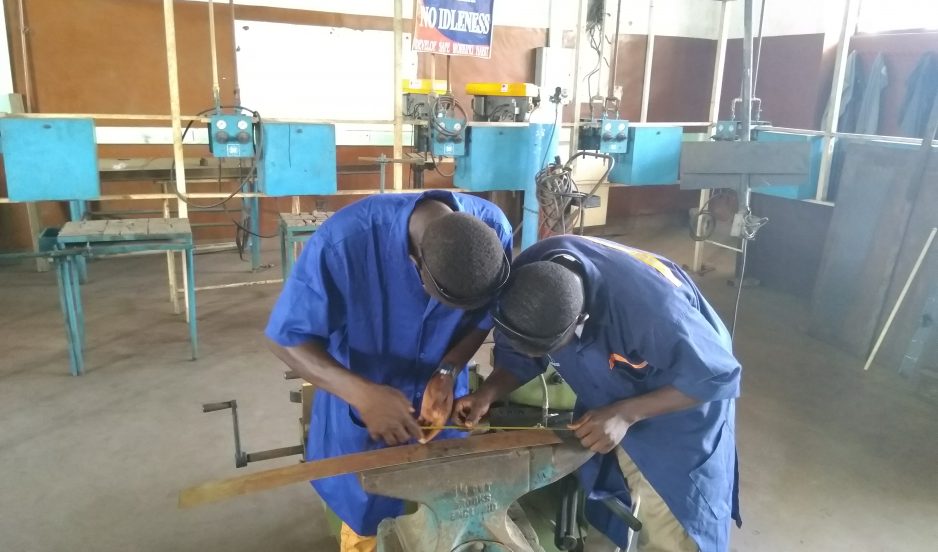Essential steps to eliminate porosity in welds with Belgrade Welding
Wiki Article
Usual Welding Repair Service Issues and Exactly How to Address Them Efficiently
Welding fixings frequently experience a variety of issues that can threaten the integrity of the end product. Common issues include insufficient penetration, porosity, and imbalance, amongst others. Each flaw provides special obstacles that need certain strategies for resolution. Recognizing these concerns is important for welders aiming to enhance their end results and abilities. This conversation will certainly check out these common welding repair work issues and efficient approaches to resolve them.Poor Infiltration
Poor infiltration takes place when the weld metal stops working to fully fuse with the base product, leading to weak joints and possible architectural failures. This concern often originates from inadequate warm input, wrong electrode angle, or improper welding rate. Welders might run into insufficient penetration as a result of a mistake of the essential parameters for a certain material density or kind. Additionally, contamination on the base material's surface area can prevent reliable bonding, worsening the issue. To address insufficient infiltration, welders ought to assure suitable setups on their tools and maintain a tidy work surface. Routine examination of welds is advised to determine any type of shortages early, permitting for timely adjustments and the prevention of compromised architectural integrity in bonded settings up.Porosity
Porosity is a typical flaw in bonded joints that materializes as little gas bubbles trapped within the weld steel. This problem can compromise the integrity of the weld, causing reduced stamina and possible failing under stress and anxiety. Montana Mobile Welding and Repair Belgrade Welding. Porosity normally develops from contamination, dampness, or improper welding methods, which enable gases to get away into the molten weld swimming pool. To attend to porosity, welders must guarantee correct surface area prep work, maintain a clean working environment, and utilize appropriate welding specifications. In addition, choosing the best filler product and shielding gas can minimize gas entrapment. Normal inspection and testing of welds can aid determine porosity early, ensuring timely restorative activities are taken, consequently maintaining the top quality and reliability of the bonded frameworkMisalignment
Misalignment in welding can emerge from different aspects, including inappropriate configuration and thermal expansion. Understanding the source is essential for effective resolution. A number of adjustment methods are available to realign elements and guarantee architectural honesty.Reasons of Misalignment
Welding imbalance typically originates from a selection of underlying issues that can jeopardize structural stability. One key cause is inappropriate fit-up of elements before welding, which can lead to spaces and uneven surfaces. Variations in thermal expansion during the welding procedure can likewise lead to distortion, particularly if the materials being signed up with have different coefficients of expansion. Additionally, poor fixturing and clamping might fall short to hold elements securely in position, causing activity throughout welding. Inadequately conserved equipment, consisting of welding equipments and tools, may introduce inconsistencies in the weld bead, more adding to imbalance. Driver mistake, stemming from not enough training or experience, can additionally play a considerable role in developing misaligned welds.
Adjustment Techniques Offered
Dealing with misalignment effectively requires a combination of corrective methods tailored to the particular concerns handy. One typical approach is the use of jigs or fixtures to hold parts in the right position throughout welding, making certain regular placement. In addition, pre-heating the materials can help decrease distortion and boost fit-up. For substantial imbalance, mechanical adjustment strategies, such as using hydraulic jacks or clamps, can be utilized to fix the setting prior to welding. Post-weld heat therapy might likewise be essential to soothe anxieties triggered by misalignment. Cautious evaluation and modification during the arrangement stage can prevent imbalance problems from ending up being significant troubles, promoting a smoother welding process and boosting general structural integrity.Distortion
Distortion is a typical challenge in welding that can develop from numerous variables, consisting of uneven cooling and heating. Understanding the reasons for distortion is essential for carrying out reliable avoidance methods. Addressing this concern not just improves architectural integrity but likewise boosts the overall quality of the weld.Reasons of Distortion
When subjected to the intense heat of welding, materials usually go through modifications that can result in distortion. This sensation largely occurs from thermal growth and contraction during the welding procedure. As the weld area warms up, the product increases; upon air conditioning, it contracts, which can create interior stresses. On top of that, uneven heating across a workpiece can exacerbate these stress and anxieties, causing bending or flexing. The type of material likewise plays a substantial duty; steels with varying thermal conductivity and coefficients of expansion might react in different ways, bring about unforeseeable distortions. Bad joint layout and poor fixturing can contribute to imbalance during welding, enhancing the possibility of distortion. Recognizing these causes is vital for reliable welding repair service and prevention strategies.Avoidance Techniques
Effective prevention strategies for distortion during welding focus on controlling heat input and making sure correct joint layout. Maintaining a regular warmth input helps to lessen thermal expansion and tightening, which can lead to distortion. Utilizing strategies such as pre-heating the work surface can also lower the temperature slope, promoting consistent home heating. In addition, picking proper joint styles, such as T-joints or lap joints, can boost stability and lower anxiety focus. Implementing correct fixturing to safeguard the workpieces in area further help in keeping placement throughout the welding procedure. Ultimately, staggered welding series can distribute warm more uniformly, protecting against local distortion. By applying these approaches, welders can greatly reduce the chance of distortion and boost the total high quality of their welds.Cracking
Splitting is a common problem come across in welding fixings, frequently resulting from various elements such as improper air conditioning prices, product choice, or insufficient joint prep work. The incident of splits can substantially compromise the stability of the weld, leading to prospective failures throughout procedure. To resolve this problem, welders have to initially assess the root causes, guaranteeing that materials work and suitably chosen for the certain application. In addition, regulating the air conditioning price during the welding procedure is necessary; quick air conditioning can induce tension and lead to cracking. Appropriate joint design and prep work additionally add to reducing the risk. Executing these techniques can boost weld top quality and resilience, ultimately minimizing the probability of fracturing in completed weldments.
Incomplete Combination
A significant problem in welding visite site repair work is incomplete combination, which occurs when the weld metal does not sufficiently bond with the base material or previous weld passes - Montana Mobile Welding and Repair Belgrade. This problem can lead to weak points in the joint, potentially compromising the stability of the bonded structure. Variables contributing to insufficient combination include not enough warm input, improper welding strategy, and contamination of the surface areas being joined. To address this concern effectively, welders should assure appropriate pre-weld cleansing and surface area preparation, in addition to readjust their welding criteria to achieve appropriate penetration and blend. Normal evaluation during the welding process can additionally help recognize insufficient combination early, permitting prompt restorative measures to enhance the general high quality of the weldOverheating
While welding repair work can boost architectural integrity, overheating presents a significant obstacle that can bring about material degradation. Too much warmth during welding can alter the mechanical residential properties of steels, resulting in reduced stamina, boosted brittleness, and bending. This sensation is particularly vital in high-stress applications where architectural dependability is vital. Identifying overheating can involve aesthetic assessments for discoloration or distortion, along with keeping an eye on temperature during the welding procedure. To mitigate the threats connected with getting too hot, welders must employ appropriate methods, such as managing warm input, adjusting traveling speed, and making use of suitable filler products. In addition, implementing pre- and post-weld heat therapies can assist bring back product residential properties and improve the total top quality of the repair, ensuring long-term performance and safety.Regularly Asked Inquiries
What Are the Usual Indications of a Welding Defect?

Just How Can I Evaluate My Welds for High quality?
To check welds for quality, one can utilize aesthetic inspections, ultrasonic testing, and radiographic techniques. Each technique guarantees architectural stability, determines problems, and verifies adherence to defined standards, eventually improving the reliability of the bonded joints.What Safety and security Safety Measures Should I Take While Welding?
company website When welding, one ought to prioritize safety and security by putting on appropriate personal protective tools, making sure correct ventilation, safeguarding combustible materials away, preserving a clean work area, and knowing surroundings to avoid injuries and crashes.Can I Fix a Weld Without Remodeling the Entire Joint?
Fixing a weld without redesigning the whole joint is feasible, depending upon the damages (Montana Mobile Welding and Repair). Techniques such as grinding, including filler product, or utilizing a welding process can efficiently resolve particular imperfections while preserving the bordering structureWhat Equipment Are Crucial for Reliable Welding Fixes?
Essential tools for reliable welding repair work include a welding equipment, cable brush, mill, protective equipment, clamps, and filler products. Each device plays an essential role in ensuring quality and safety during the fixing process. Porosity usually emerges from contamination, moisture, or improper welding strategies, which allow gases to leave into the liquified weld pool. Inadequately conserved devices, consisting of welding machines and tools, may introduce incongruities in the weld grain, further contributing to misalignment. When subjected to the intense warm of welding, products typically go through modifications that can lead to distortion. Breaking is a typical concern encountered in welding repairs, frequently resulting from various factors such as incorrect air conditioning rates, product selection, or insufficient joint prep work. A substantial problem in welding repairs is insufficient combination, which occurs when the weld steel does not properly bond with the base material or look at more info previous weld passes.Report this wiki page